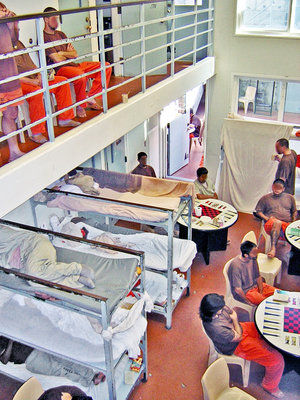
“Trying to house all these inmates is like trying to solve a really complicated human sudoku puzzle,” Chief Deputy Jeff Marsh, who oversees Santa Cruz County’s four adult jails, said grimly. “It keeps me up at night, quite frankly.”
The county jail system is so overcrowded that any free space is being converted into living quarters. Making matter worse are budget restraints and looming legislation that could increase county inmate populations, sending officials scrambling to solve a complex equation that has no apparent solution.
The county launched a task force last week that will be dedicated to easing the overcrowding.
County Jail, the main jail on Water Street in Santa Cruz, is over capacity, housing about 350 inmates when it’s made to hold 311 people, Marsh said.
The Santa Cruz County Sheriff’s Office, which runs all the adult jails in the county, closed the minimum-security portion of the Rountree jail in Watsonville, also known as the Jail Farm, in January. At the time, it was running well below its maximum capacity.
“This was because of alternatives to incarceration, like work programs and things like that,” Marsh said.
The inmates were moved from the Farm to one side of the medium-security building in Watsonville.
“But since then, the main jail has risen to 399,” Marsh said. “Now that the Farm is closed, we no longer have it as a relief valve.”
Because of budget constraints, Marsh said, it isn’t feasible to reopen the Farm, which costs about $1 million a year to run.
Marsh said the loss of the Farm has meant tighter populations at the jail on Water Street and the medium-security Rountree facility, but that doesn’t account entirely for the overcrowding.
It is unclear why the jail population is rising, Marsh said.
“It could be many things,” he said. “But arrests have been about the same during the last three years. The task force has been called because there is no obvious reason.”
The Jail Overcrowding Task Force, which met for the first time last week and will meet again Oct. 20, is made up of law enforcement officials, staff from the district attorney’s and public defenders offices, local judges and other groups that work in the jail.
The county formed a similar group in 2004, when the main jail population rose to about 400 inmates, Marsh said. Incarcerations declined with interventions like alternative sentencing, and for a while, the jail ran below capacity.
But the main jail on Water Street is maxed out again, Marsh said. Areas designed to be day rooms have been converted to sleeping quarters with bunk beds and “boats,” plastic tray-like beds that go wherever there’s open floor space, Marsh said.
Marsh said a state audit of the jail system that could lead to a cap on the number of inmates in each jail could require a one-person-in, one-out policy.
The overcrowding hinders services to inmates, because the number of workers assigned to each jail doesn’t account for the population rise. Chances of violence are also higher, but even so, Marsh said jail workers haven’t seen more assaults behind bars.
“Despite everything, things are running pretty smoothly for now,” he said. “But it gets more and more difficult, the more crowded we are.”
Making matters more complicated is a provision in the yet-to-be-approved state budget, which would mandate that all state prison inmates sentenced to three years or fewer behind bars serve that time at county jails instead of California state prisons.
“The clause is an effort to save money for the state and ease prison overcrowding, but it affects local county jails a great deal,” Marsh explained. “If this is passed with the budget, not only am I going to have more inmates — they’re going to be here for three years.”
But overcrowding in the state prison system is worse yet, according to Assemblymember Bill Monning (D-Santa Cruz).
The state has 170,000 inmates, with all prisons packed at more than 100 percent capacity (some at over 200 percent). The next governor could be faced with reducing that number by 40,000.
“Many inmates are triple-bunked in gymnasiums, and the state is under federal court order to reduce overcrowding,” Monning said.
Monning said there are elements in the state budget that relate to overall prison overcrowding, like a clause that would allow county jail systems to voluntarily house certain classification inmates at a lower cost to the state.
Housing an inmate in state prison costs around $50,000, Monning said. It costs $30,000 to house an inmate in county jail.
The state would pay the participating counties a predetermined amount, the assemblyman said.
“However, if a county system is overcrowded, it’s probably not going to use that option,” Monning said. “We’ve also discussed some early-release programs, but Republicans are never in favor of that.”
Regardless of political party support, Barrios Unidos outreach coordinator David Beaudry said prisons are filled with many people who should be released, rather than trickled into county jails.
“I’m not saying that everyone in prison doesn’t belong there, but there are a lot of people that should be home now,” Beaudry said. “There are also people that shouldn’t be in there, like those that are in because of things like racial profiling and parole injunctions.”
Barrios Unidos, a nonprofit, aims to actively prevent violence among young people in Santa Cruz County and also advocates for prison reform.
“I’ve seen so many lifers that are ready to go home, that have done crimes when they were in their teens (and) are now in their 50s and 60s and just want to go home and make a difference in their communities,” Beaudry said. “You look into their eyes, and you know they are telling the truth.”












